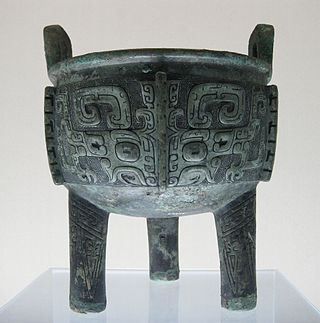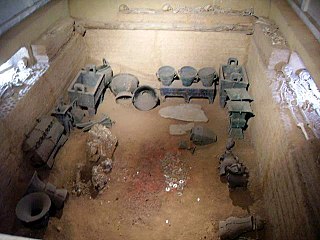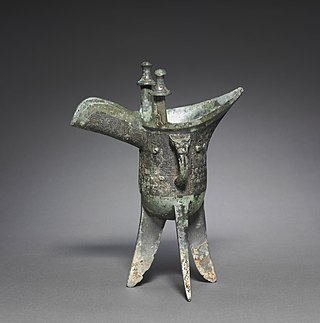
The Shang dynasty,also known as the Yin dynasty,was a Chinese royal dynasty that ruled in the Yellow River valley during the second millennium BC,traditionally succeeding the Xia dynasty and followed by the Western Zhou dynasty. The classic account of the Shang comes from texts such as the Book of Documents,Bamboo Annals and Records of the Grand Historian. Modern scholarship dates the dynasty between the 16th and 11th centuries BC,with more agreement surrounding the end date than beginning date.

Chinese art is visual art that originated in or is practiced in China,Greater China or by Chinese artists. Art created by Chinese residing outside of China can also be considered a part of Chinese art when it is based on or draws on Chinese culture,heritage,and history. Early "Stone Age art" dates back to 10,000 BC,mostly consisting of simple pottery and sculptures. After that period,Chinese art,like Chinese history,was typically classified by the succession of ruling dynasties of Chinese emperors,most of which lasted several hundred years. The Palace Museum in Beijing and the National Palace Museum in Taipei contains extensive collections of Chinese art.
The Western Zhou was a period of Chinese history corresponding roughly to the first half of the Zhou dynasty. It began when King Wu of Zhou overthrew the Shang dynasty at the Battle of Muye and ended in 771 BC when Quanrong pastoralists sacked the Zhou capital at Haojing and killed King You of Zhou. The "Western" label for the period refers to the location of the Zhou royal capitals,which were clustered in the Wei River valley near present-day Xi'an.

Chinese bronze inscriptions,also commonly referred to as bronze script or bronzeware script,are writing in a variety of Chinese scripts on ritual bronzes such as zhōng bells and dǐng tripodal cauldrons from the Shang dynasty to the Zhou dynasty and even later. Early bronze inscriptions were almost always cast,while later inscriptions were often engraved after the bronze was cast. The bronze inscriptions are one of the earliest scripts in the Chinese family of scripts,preceded by the oracle bone script.

The zun or yi,used until the Northern Song (960–1126) is a type of Chinese ritual bronze or ceramic wine vessel with a round or square vase-like form,sometimes in the shape of an animal,first appearing in the Shang dynasty. Used in religious ceremonies to hold wine,the zun has a wide lip to facilitate pouring. Vessels have been found in the shape of a dragon,an ox,a goose,and more. One notable zun is the He zun from the Western Zhou.

Ding are prehistoric and ancient Chinese cauldrons standing upon legs with a lid and two fancy facing handles. They are one of the most important shapes used in Chinese ritual bronzes. They were made in two shapes:round vessels with three legs and rectangular ones with four,the latter often called fāng dǐng "square ding (方鼎. They were used for cooking,storage,and ritual offerings to the gods or to ancestors.

A guang or gong is a particular shape used in Chinese art for vessels,originally made as Chinese ritual bronzes in the Shang dynasty,and sometimes later in Chinese porcelain. They are a type of ewer which was used for pouring rice wine at ritual banquets,and often deposited as grave goods in high-status burial. Examples of the shape may be described as ewers,ritual wine vessels,wine pourers and similar terms,though all of these terms are also used of a number of other shapes,especially the smaller tripod jue and the larger zun.

The Tomb of Fu Hao lies within Yinxu,the site of the Late Shang capital,within the modern city of Anyang in Henan Province,China. The tomb was discovered in 1976 by Zheng Zhenxiang and excavated by the Anyang Working Team of the Archaeological Institute of the Chinese Academy of Social Sciences,who designated the tomb as M5. It is to date the only Shang royal tomb found intact with its contents and excavated by archaeologists.

The National Museum of China is an art and history museum located on the eastern side of Tiananmen Square in Beijing,China. The National Museum of China has a total construction area of about 200,000 square meters,a collection of more than 1.4 million items,and 48 exhibition halls. It is the museum with the largest single building area in the world and the museum with the richest collection of Chinese cultural relics. It is a level-1 public welfare institution funded by the Ministry of Culture and Tourism.

Chinese jade refers to the jade mined or carved in China from the Neolithic onward. It is the primary hardstone of Chinese sculpture. Although deep and bright green jadeite is better known in Europe,for most of China's history,jade has come in a variety of colors and white "mutton-fat" nephrite was the most highly praised and prized. Native sources in Henan and along the Yangtze were exploited since prehistoric times and have largely been exhausted;most Chinese jade today is extracted from the northwestern province of Xinjiang.

From c. 1650 BC,elaborately decorated bronze vessels were deposited as grave goods in the tombs of royalty and nobility during the Chinese Bronze Age. Documented excavations have found over 200 pieces in a single royal tomb. They were produced for an individual or social group to use in making ritual offerings of food and drink to his or their ancestors and other deities or spirits. Such ceremonies generally took place in family temples or ceremonial halls over tombs. These ceremonies can be seen as ritual banquets in which both living and dead members of a family were supposed to participate. Details of these ritual ceremonies are preserved through early literary records. On the death of the owner of a ritual bronze,it would often be placed in his tomb,so that he could continue to pay his respects in the afterlife;other examples were cast specifically as grave goods. Indeed,many surviving examples have been excavated from graves.

A jue is a type of ancient Chinese vessel used to serve warm wine during ancestor-worship ceremonies. It takes the form of an ovoid body supported by three splayed triangular legs,with a long curved spout on one side and a counterbalancing flange on the other. Many examples have one or two loop handles on the side and two column-shaped protuberances on the top of the vessel,which were probably used to enable the vessel to be lifted using leather straps. They are often ornately decorated with taotie decorations representing mythical beasts. They are in effect a small Chinese equivalent of the ewer. The name jue is not original,but derives from the Shuowen Jiezi,a dictionary of the 2nd century AD.

A hu is a type of wine vessel that has a pear-shaped cross-section. Its body swells and flares into a narrow neck,creating S-shaped profile. While it is similar to you vessel,hu usually has a longer body and neck. The shape of hu probably derives from its ceramic prototype prior to the Shang dynasty. They usually have handles on the top or rings attached to each side of neck. Many extant hu lack lids while those excavated in such tombs as Fu Hao's indicate that this type of vessel might be originally made with lids. Although it is more often to see hu having a circular body,there also appears hu in square and flat rectangular forms,called fang hu and bian huArchived 2015-09-23 at the Wayback Machine in Chinese. In addition,hu often came to be found in a pair or in a set together with other types of vessels. As wine had played an important part in the Shang ritual,the hu vessel might be placed in the grave of an ancestor as part of ritual in order to ensure a good relationship with ancestor's spirit.

A jia is a ritual vessel type found in both pottery and bronze forms;it was used to hold libations of wine for the veneration of ancestors. It was made either with four legs or in the form of a tripod and included two pillar-like protrusions on the rim that were possibly used to suspend the vessel over heat. The earliest evidence of the Jia vessel type appears during the Neolithic Period. It was a prominent form during the Shang and early Western Zhou dynasties,but had disappeared by the mid-Western Zhou.

The Tomb of Marquis Yi of Zeng is an archaeological site in Leigudun Community (擂鼓墩社區),Nanjiao Subdistrict (南郊街道),Zengdu District,Suizhou,Hubei,China,dated sometime after 433 BC. The tomb contained the remains of Marquis Yi of Zeng,and is one of a handful of ancient Chinese royal tombs to have been discovered intact and then excavated using modern archaeological methods. Zeng was a state during the Spring and Autumn period of China. The tomb was made around 433 BC,either at the end of the Spring and Autumn period or the start of the Warring States period. The tomb comes from the end of the thousand-year-long period of the burial of large sets of Chinese ritual bronzes in elite tombs,and is also unusual in containing large numbers of musical instruments,including the great set of bells for which it is most famous.

A dui is a type of Chinese ritual bronze vessel used in the late Zhou dynasty and the Warring States period of ancient China. It was a food container used as a ritual vessel. Most dui consist of two bowls supported on three legs.

A gu is a type of ancient Chinese ritual bronze vessel from the Shang and Zhou dynasties. It was used to drink wine or to offer ritual libations.

The Kang Hou gui is a bronze vessel that is said to have been taken from the city of Huixian,Henan province,central China. Dating to the Western Zhou period,this ancient Chinese artefact is famous for its inscription on the bottom of the interior. It has been part of the British Museum's Asian Collections since 1977.
Shu of Wey–Kang or Kang-shu of Wey,Shu Feng of Kang,also known as given name Feng (封),Temple name Liezu (烈祖) was a Zhou dynasty feudal lord and the founder of the state of Wey. He was the ninth son of Ji Chang,King Wen of Zhou. Feng was also the full-brother of King Wu of Zhou,Duke of Zhou,Shu Zhenduo of Cao and Gao,Duke of Bi.

A fangyi is a type of Chinese ritual bronze container typical of the Shang and early to middle Zhou periods of Bronze Age China. It takes the shape of a square or rectangular casket with a cover that resembles a hip roof,surmounted by a knob of a similar hipped appearance. The lower edge is typically indented with a semi-circular notch.





















